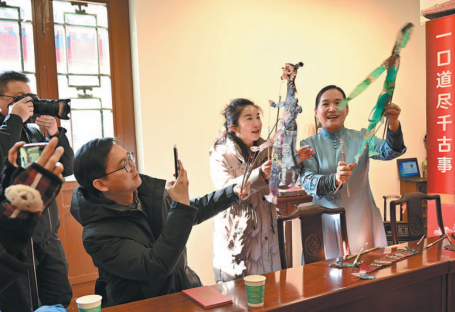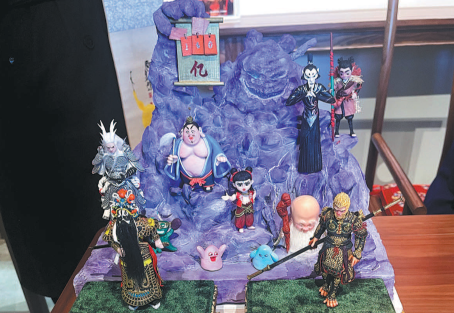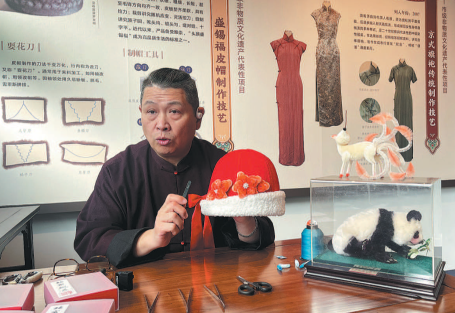Traditional crafts find modern place

Artist of dough figurines incorporates popular characters in national intangible heritage as a way to preserve the past, Yang Feiyue reports.
In a side room of a Qing Dynasty (1644-1911)-styled courtyard adorned with red corridors, green wooden pillars and a gray-tiled roof, Lang Jiaziyu elicited gasps of amazement from the audience with his lifelike dough models.
Inspired by the recent box-office hit Ne Zha 2, the man, 30, created dough figurines of several of the animation's protagonists with a timer marking its box-office milestones.
"It was an improvised solution to highlight the constantly changing records," says Lang, who has practiced dough figurine for almost two decades, an art form listed as a national intangible cultural heritage in 2008.
A native of Beijing, Lang infuses his artistic vision into his work by incorporating characters from the popular game Black Myth: Wukong and historical figures like Xiang Yu, a warlord from the late Qin Dynasty (221-206 BC).
The audience, curious about the materials and techniques used in making dough figurines, listened intently as Lang revealed the tricks, which involve ordinary ingredients — wheat flour, glutinous rice flour, honey, salt, and water-soluble pigments — readily available items at local supermarkets.
However, the process is anything but simple.
The flour must be sifted to remove coarse particles, leaving only the finest. This refined mixture is then kneaded into colorful dough, which is meticulously shaped into intricate figures.
"These products showcase my efforts of blending a traditional craft with modern culture to appeal to younger audiences while ensuring that the past and present are represented in my work," Lang says.
The history of dough figurines dates back to the Qin Dynasty when they were used as sacrificial offerings in the form of miniature livestock, Lang says.
"By the Ming (1368-1644) and Qing dynasties, the art form peaked, coinciding with the rise of traditional Chinese opera. During this period, dough figurines became akin to today's collectible figurines, representing beloved characters from operas and folklore," he explains.
Under Lang's guidance, some attendees attempted their own creations.
Black, white and green doughs were carefully kneaded, rolled, and pinched to transform into a charming panda, complete with beady eyes, a bamboo stalk, and a tiny patch of grass.
A visitor surnamed Hu pulled of her very first dough panda under Lang's instructions.
"I've played with modeling clay before, but that was more like industrial products that are light and feel completely different from this (dough figurine). It has a unique texture — it feels like food, very traditional, interesting, and fun," Hu says.
Dough figurines were among several intangible cultural heritage crafts showcased at the Beijing 2022 Winter Olympics, alongside velvet flowers, painted opera masks, shadow puppetry, and woodblock printing. In late February, these art forms were celebrated at the Beijing Intangible Cultural Heritage Center, housed within the ancient courtyard complex.
The event highlighted the capital's cultural legacy tied to the Winter Olympics, says Su Jing, deputy director of the Beijing culture and art inheritance and development center affiliated with the Beijing Municipal Bureau of Culture and Tourism.
"We wanted to revisit the intangible cultural heritage projects that served the Olympics and celebrate their contributions to this historic event," Su adds.
On the third anniversary of the Winter Olympics, the gathering brought together over 50 representatives from the travel industry, cultural heritage practitioners, and members of the Olympics operations team to explore collaboration opportunities.
"We'd like to have professionals from hotels and travel agencies experience these intangible cultural heritage projects and create opportunities to integrate them into modern tourism and hospitality, ensuring their survival and relevance," Su says.
At the event, business representatives and cultural heritage inheritors forged agreements to co-develop creative cultural products and host workshops for employees.
Beijing's famous chain restaurant Quanjude, whose roast duck technique was named an intangible cultural heritage in Beijing's Xicheng district in 2008, delivered Olympic-themed pastries, including two-tone hockey pucks made of purple sweet potato, yam and curling stone-shaped macarons.
The restaurant brand provided catering services to the Winter Olympics.
"The hockey pucks carry a sweet Osmanthus flavor, while the macarons have strawberry and blueberry notes," says Ma Zhenbin, the cold dish chef at Quanjude's Olympic Park branch.
At the last stop of the exhibition, velvet flower brooches handmade by Cai Zhiwei, an inheritor of the velvet bird and flower craft, a Beijing intangible cultural heritage, were quickly snatched up.
The art form's link to the Winter Olympics lies in its use as hat ornaments for the awarding ceremony.
Inspired by Dunhuang murals, the designs feature a lotus and peony motif in blue and red.
"The red was vivid yet subtle, with four tonal variations," Cai recalls, adding that the perfect hue was achieved after his team experimented with various dyes.
Cai, who has practiced the art for over two decades, explains that velvet crafting is not limited to birds and flowers, as its name might suggest.
"We create animals, insects, and even landscapes," he says, pointing to his delicate works, including a nine-tailed fox and a panda made from raw silk wrapped around a thin copper wire, amenable to manual manipulation.
"The material is stiff like human hair and softened for floral designs, resulting in a velvety texture that is visually and tactilely stunning," he adds.
However, mastering the art demands patience and resilience.
"Every step, from shaping the silk to assembling the pieces, must be done by hand," he emphasizes.
"The hardest part is enduring the monotony, as twisting copper wires and shaping silk strands can be tedious, but the results are worth it," he says.
More events of this nature will be hosted at the Beijing Intangible Cultural Heritage Center to expand public engagement and explore new avenues for cultural preservation, according to authorities.
"We aim to create more channels for people to experience and appreciate these heritage crafts," Su says.
Fan Yingjie, a senior manager with a Beijing-based travel agency, says he is blown away by the presentation of the cultural heritage displayed at the event.
"Those heritages are important part of Chinese culture," Fan says.
His agency has launched certain travel routes that enable travelers to get close to cultural heritage, and it has received positive reviews.
Lang vividly recalls when he presented two dough figurines of Bing Dwen Dwen, the Olympic mascot, to Albert II, Prince of Monaco, at the Great Hall of the People during the Winter Olympics.
"I gifted him a Bing Dwen Dwen and he humorously requested a second one, explaining that he needed two because he has twins," Lang recalls.
The experience fueled Lang's commitment to keeping this ancient craft alive by infusing it with contemporary relevance.
"Through my work, I hope to inspire a deeper appreciation for this unique art form, proving that even the oldest traditional crafts can find a place in modern culture. After all, intangible cultural heritage is not just about preserving the past — it's about shaping the future," he says.
Contact the writer at yangfeiyue@chinadaily.com.cn
























